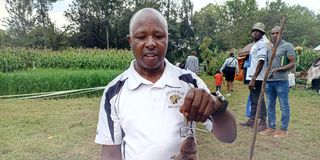Biz Lounge: Nakuru man making a killing building and selling mole traps

James Irungu demonstrates how the mole trap functions at the Nakuru Agricultural show on 5th July, 2025.
Four years ago, James Irungu rented an eighth of an acre to try his hand at potato farming. What seemed like a promising venture quickly turned into a night mare. Unknown to him, the land was heavily infested with moles.
“I later found out the landowner had stopped farming on it because of the moles,” he says. “But I was determined, so I took a loan and went ahead with the plan.”
Despite his commitment, the harvest was so poor that he made no profit. Things got so bad that he had to sell his dairy goat just to repay the loan he had taken to start the farm.
Cornered but not defeated, Irungu turned to innovation. He began designing a pest trap that could deal with both moles and rats.
“I started with wooden traps, but they weren’t effective. That’s when I switched to metal,” he explains.
Though the early results were discouraging, the metallic traps proved far more reliable. As he refined his design, the pest problem on his farm began to disappear and soon, neighboring farmers took notice.
“Even though I didn’t go on with potato farming, I saw an opportunity. Many farmers were struggling with the same pest issue, and those who used my traps started seeing real improvements,” he says.
With only Sh3,000, Irungu began producing the traps. At first, much of the material went to waste due to trial and error, and the high cost of iron sheets made it even harder to stay afloat.
“It took me six months to perfect the trap,” he says. “Now, I’ve settled on an effective design, and that’s the one I sell to farmers.”
He sells each trap for Sh350, delivering them on order. Most of his customers come through word-of-mouth referrals. On average, he sells about 150 units a month and supplies up to 50 farmers during peak seasons.
Irungu handcrafts each trap using iron sheets, wire, and a simple set of tools; a hammer and pliers. He finishes each unit with two coats of spray paint to give it a polished look.
“The profits have already allowed me to reinvest in my initial passion. I bought another dairy goat and a fodder chopping machine,” Irungu says proudly.
Looking ahead, Irungu’s five-year plan is to scale up pest-trap production as a side business and fully transition into dairy goat farming a field he’s always wanted to pursue.
For Irungu, the business is more than just income. It’s about solving a real problem for fellow farmers.
“I taught myself everything. Every time I failed, I fixed it and improved. It’s fulfilling to hear farmers say the traps have helped them boost production,” he says with pride.


